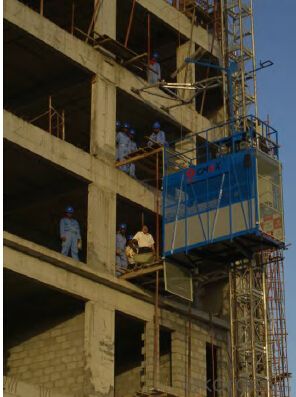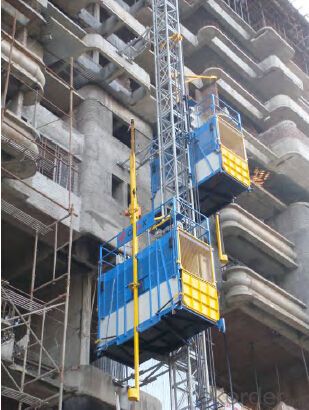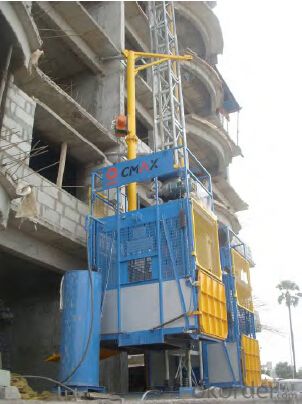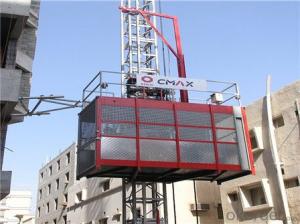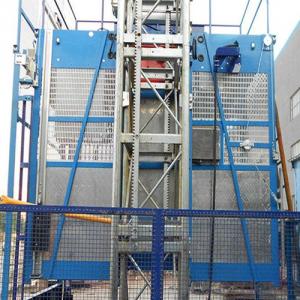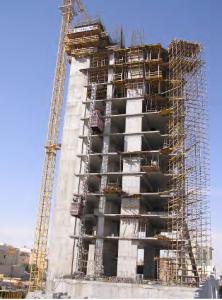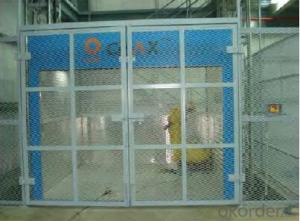Building Hoist SC150/150D ,Courage to Innovate and Pursue Excellence in Work
- Loading Port:
- Guangzhou
- Payment Terms:
- TT or LC
- Min Order Qty:
- -
- Supply Capability:
- 30 unit/month
OKorder Service Pledge
OKorder Financial Service
You Might Also Like
SC Hoist is a Rack and Pinion EL. Lift, used on construction site for transportation of personnel and materials. It is installed and dismounted conveniently and can grow as high as the buildings grow in height.
There are single cage and twin cage hoists. A single cage can be quickly transformed into twin cage hoist by adding a cage and other parts. The hoist payload can be increased by adding counterweight equipment.
SC Hoist has reliable electrical and mechanical safety device. It is a efficient and safety vertical transporting equipment.
Main Parts of Building Hoist
1. Adopts the most advanced VF speed control device and microcomputer programmable logic controller.
2. Stepless speed control helps eliminate the concussion during start up and braking, steady the operation process, and ensures automated leveling.
3. Adopts open loop V/Fcontrol; the speed control precision can reach ±2~3%. Realizes accurate low speed positioning of the hoist and avoid slipping during downward stopping of hoist.
4. The VF system has current-restriction function, ensuring a small current when motor start up and reducing the concussion to power supply. It reduces the engery consumption and mitigates effects to on site electric equipments.
5. The steadiness during running mitigates concussion to mechanical parts, reduces wears of rack, pinion and the brake and prolongs the spare parts'life.
6. The VF system also has the over voltage protection,low voltage protection, overcurrent, overload and anti-stalling protection functions,
7. The system applies the special software for hoists developed by our company, making the operation more safe and reliable.
Building Hoist images
CMAX Building Hoist
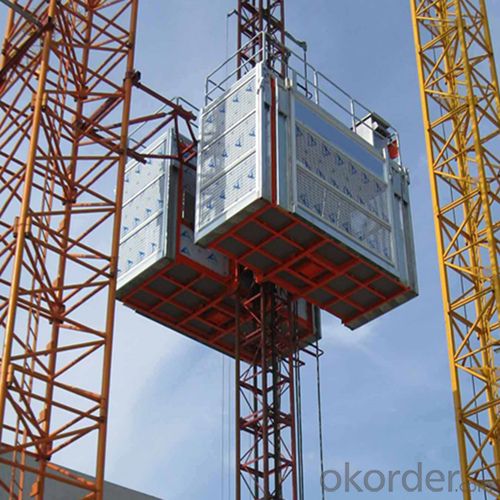
Mast sections
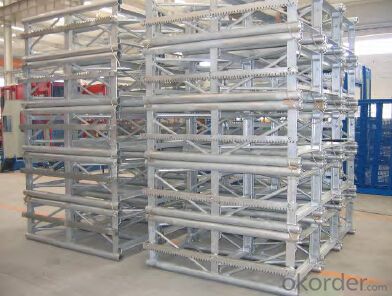
Driving Unit
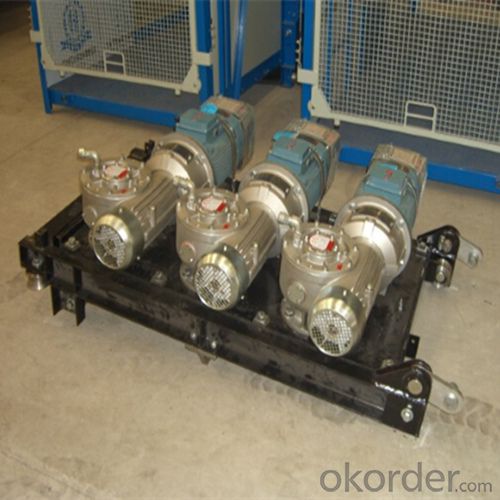
Warehouse
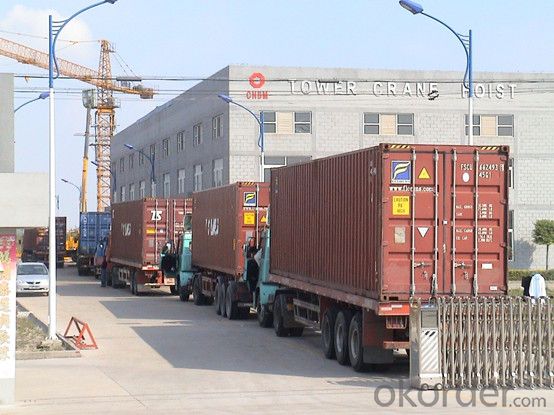
Building Hoist Specifiction
Main technical data | Unit | Value |
Rated load | kg | 2×1500 |
Rated erection load | kg | 2×1000 |
Jib attachment rated load | kg | 300 |
Cage size | m | 3.0×1.3×2.5 |
Maximum lifting height | m | 250 |
Lifting speed | m/min | 0~33 |
Rated output | kW | 2×2×18.5 |
Voltage rating | V | 380/440 |
Rated frequency | Hz | 50/60 |
Rated current | A | 2×2×37.8 |
Power supply fuses | A | 96 |
Protective class | / | IP55 |
Load duration factor | / | FC-25% |
Safety device | m/s | 1.2 |
Enclosure weight | kg | 1480 |
Cage weight | kg | 2×1850 |
Counterweight | kg | / |
Mast section weight | kg | 150/170/190 |
Mast section length | mm | 1508 |
If you have special requirement on power, please state it when order the consignment.
We can produce the cage and lengthen the tie-in according to the size the customer requested.
We can heighten the erection height according to the customer’s request.
“/” means the item does not exist.
FAQ of Building Hoist
Q: What is the building hoist main purpose?
A: Building hoist equipped with double or single cabin to transport the materials and labors up and down. It's the ideal construction equipment for vertical transportation in the field of construction.
Q: What is the main structure of building hoist?
A: The P/M construction hoist mainly contains metal structure, driving system, electrical control system, cable guide & protection system, electrical top crane and safety device.
Q: What is the meaning of the building hoist’s code?
A: Take SC200/200 for example: “SC” stands for rack and pinion hoist, “200/200” stands for double cage and capacity is 2 tons per cage. “SC200” stands for single cage and capacity is 2 tons.
Q: What is the dimension of the cage?
A: Normally the cage dimension is 3X1.5X2.5M (L/W/H) for 2t type hoist. Details should be checked according to our quotation sheet. Also, the size can be customized according to the factual site condition. There are two doors (entrance & exit doors) for each cage, It can be produced as up & down sliding or ramping model for safety and convenience.
【Corporate Vision】
Vision:Become an ever-green construction machinery enterprise and maximally meet customers’ requirements
【Core Values】
Quality: High quality, innovation, safety and reliability.
High quality is the basis of the enterprise.
Innovation is the soul of the enterprise.
Safety is reverence to life.
Reliability wins the trust.
Service: Customer focused, customers are existence value , do what we have promised.
Responsibility: Attentive and responsible, brave to undertake and fully perform individual, company and social responsibility.
【Spirit】
Hard Work:Industry, simplicity, perseverance and hardships are the source power of Yuhuaxing to achieve transnormal and leapfrog development.
Struggle:Concentrated reflection of brave advance, assiduous seeking, brave challenge and enthusiasm and progress of Yuhuaxing people.
Pioneering & Progress:Promote traditions, keep pace with the times, have the courage to innovate and pursue excellence in work
- Q: Describe the routine maintenance and inspection procedures for a building hoist.
- <p>The maintenance and inspection process for a building hoist involves several key steps to ensure safety and functionality. Regular visual inspections should be conducted to check for any visible damage or wear. Monthly inspections should include testing the emergency stop and limit switches, as well as lubricating moving parts. Quarterly inspections may involve checking the electrical connections and verifying the correct operation of safety devices. Annual inspections typically require a thorough examination by a qualified person, including testing the load-bearing capacity and ensuring all safety features are in good working order. Additionally, records of all inspections and maintenance should be kept for reference and compliance with safety regulations.</p>
- Q: How to save the elevator accident
- Expert clew Do not take an elevator with no safety check mark. The elevator person is safe to protect the condition, the passenger has no life danger, after the alarm, the patient wait for the person to help. When emergency situations such as earthquake, fire and elevator water are taken, the use of an elevator should not be used and the emergency passage or staircase should be used instead.
- Q: This question asks for the method to determine the maximum weight that a building hoist can safely lift.
- <p>To calculate the lifting capacity of a building hoist, you need to consider several factors. First, identify the hoist's rated capacity, which is usually specified by the manufacturer. This is the maximum weight the hoist is designed to lift. Next, assess the condition of the hoist, including any wear and tear that might affect its performance. Check the hoist's mechanical components, such as cables, pulleys, and motors, to ensure they are in good working order. Additionally, consider the weight of the load you intend to lift and any additional factors like the frequency of lifts or the height of the lift. Always operate within the hoist's rated capacity and follow safety guidelines to prevent accidents.</p>
- Q: This question asks for steps to ensure that lifting equipment is safe and reliable before it is used.
- <p>To ensure your lifting equipment is safe and reliable before use, follow these steps: Inspect the equipment for any visible damage or wear. Check all safety features such as hooks, cables, and brakes. Ensure that the equipment is properly maintained and serviced according to the manufacturer's guidelines. Verify that all safety certifications and inspection records are up to date. Conduct a thorough pre-use check, including testing the equipment's lifting capacity and stability. Ensure that all operators are trained and certified to use the equipment. Never use equipment that has not been inspected or is showing signs of damage. Always follow the manufacturer's guidelines and safety protocols.</p>
- Q: This question asks for an explanation of how to use an overload protection device specifically in the context of a building hoist.
- <p>An overload protection device is crucial for a building hoist to prevent accidents caused by excessive weight. First, ensure the device is correctly installed and calibrated according to the manufacturer's instructions. Before operating the hoist, set the overload limit based on the hoist's capacity. During operation, if the load exceeds the set limit, the device should automatically shut down the hoist, preventing further operation. Regularly inspect and test the device to ensure it functions properly. Always follow safety protocols and never attempt to bypass or disable the overload protection system.</p>
- Q: The user is asking if it's possible to substitute a hydraulic lifting device for a building hoist in construction.
- <p>Yes, a hydraulic lifting device can be used as an alternative to a building hoist in certain scenarios. Hydraulic devices offer precise control and smooth operation, which can be advantageous for lifting heavy construction materials. However, it's important to consider the specific requirements of your project, such as the weight and size of the materials to be lifted, the height of the lift, and the frequency of use. Hydraulic systems are generally more expensive and require more maintenance than building hoists, but they can provide greater lifting capacity and versatility. Always ensure that any lifting device used complies with safety standards and regulations.</p>
- Q: Is it possible to integrate a single-rope lifting mechanism into an electric-hydraulic lifting system?
- <p>Yes, a single-rope lifting system can be used in an electric-hydraulic lifting system. The electric-hydraulic system provides the power to lift and lower the load, while the single-rope system manages the vertical movement of the load. This combination allows for precise control and can be advantageous in applications requiring both the lifting capacity of hydraulics and the simplicity of a single-rope system. However, the design must ensure compatibility between the mechanical and hydraulic components to function effectively and safely.</p>
- Q: This question asks about the procedures and practices for regularly maintaining and inspecting a building hoist to ensure its safe and efficient operation.
- <p>Regular maintenance and inspection of a building hoist are crucial for safety and efficiency. It involves daily checks before use, including visual inspections for any visible damage, proper functioning of safety devices, and ensuring the hoist is clean and free of debris. Weekly inspections should focus on the mechanical components, such as gears, cables, and brakes, and checking for any unusual noises or vibrations. Monthly inspections may include more in-depth checks of the electrical systems and the structural integrity of the hoist. Annual inspections typically involve a thorough examination by a certified professional, who will assess the overall condition and safety of the hoist, ensuring it complies with all relevant safety standards. Always follow the manufacturer's guidelines and local regulations for maintenance and inspection schedules.</p>
- Q: Is it possible to use a building hoist to lift various materials simultaneously?
- <p>Yes, a building hoist can be used for lifting multiple materials at once, provided the total weight does not exceed the hoist's load capacity. It's crucial to ensure that the materials are securely fastened and balanced to prevent tipping or damage. Always follow the manufacturer's guidelines and safety regulations to avoid accidents and ensure the safe operation of the hoist.</p>
- Q: Is it possible to utilize a building hoist for construction or renovation purposes?
- <p>Yes, a building hoist is commonly used for construction and renovation work. It is designed to lift materials and workers vertically, making it an essential tool for multi-story construction projects. Hoists facilitate the movement of heavy materials like cement, bricks, and steel, as well as personnel, enhancing efficiency and safety on the construction site. They are particularly useful in scenarios where cranes are impractical or unavailable, making them a vital component in the construction and renovation process.</p>
Send your message to us
Building Hoist SC150/150D ,Courage to Innovate and Pursue Excellence in Work
- Loading Port:
- Guangzhou
- Payment Terms:
- TT or LC
- Min Order Qty:
- -
- Supply Capability:
- 30 unit/month
OKorder Service Pledge
OKorder Financial Service
Similar products
Hot products
Hot Searches
Related keywords



